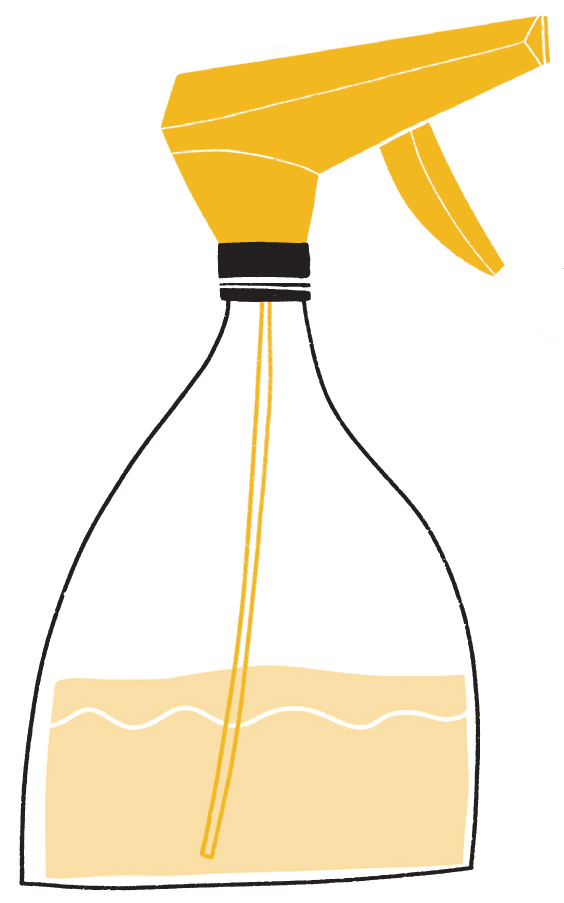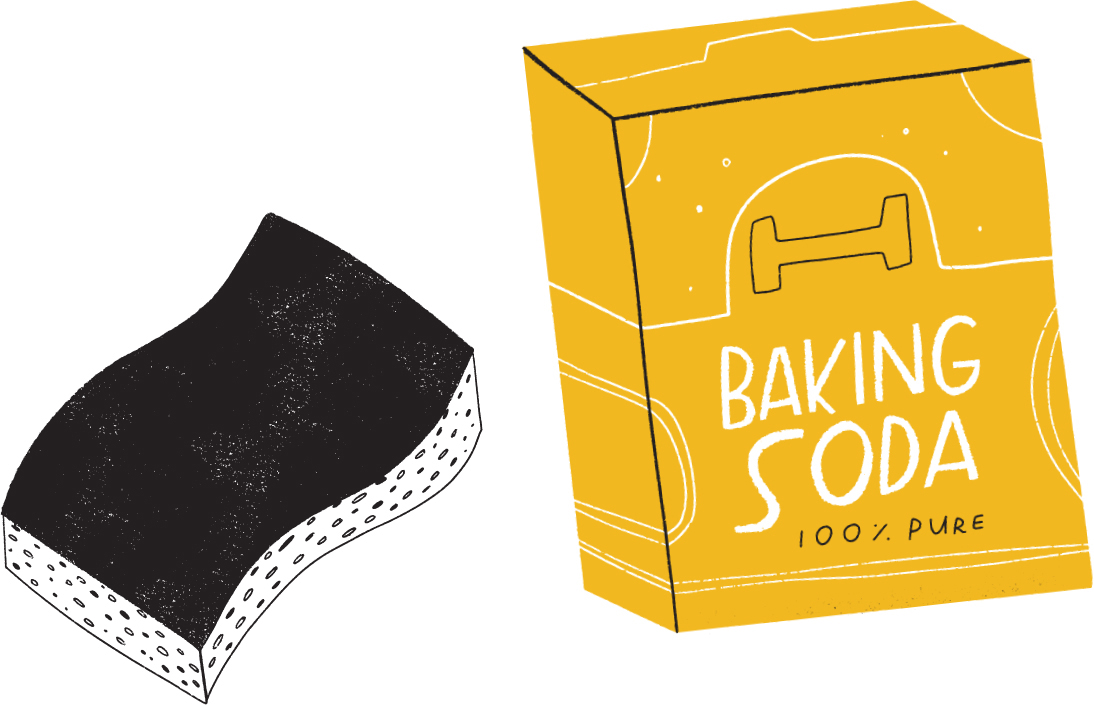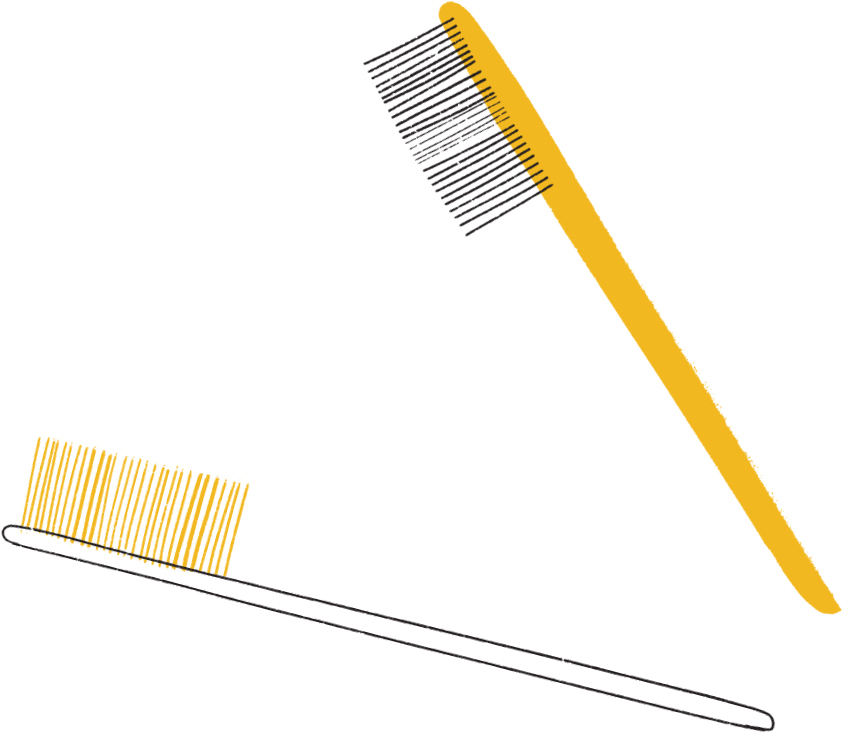CHAPTER 5
THE BATHROOM
Aside from the front door, the bathroom door is the most likely to be locked in any home. This is because in the bathroom we are frequently at our most vulnerable, engaged in such highly personal activities as shaving our legs, cleaning our ears, and holding court on the porcelain throne, to name just three. Of all the rooms in the home, the bathroom perhaps deserves our deepest gratitude and our most sincere condolences. For it is here that we shed the worst parts of our physical selves in order to emerge, transformed, ready for whatever life brings us. And the bathroom just sits there and takes it, keeping some of our closest secrets safe and asking for very little in return. The recipes in this chapter are perfect for showing your bathroom how much you appreciate it for all the many favors it has done for you.
Bathroom Sink and Bathtub Drain Clog Remover
Most clogged drains begin with hair trapped in the pipe, close to the drain opening. The hair then traps other materials, such as fingernails, dirt, and soap scum, and so the clog grows over time. If you notice the water in your sink or tub draining more slowly than usual, clear the blockage before it becomes a bigger problem.

• First, attempt to remove the clog with a homemade drain snake: Take either a medium zip tie (for a sink drain) or a large zip tie (for a bathtub drain) and, using a carpet knife or sharp wire-cutters, cut three or four parallel lines about 1½ inches (4 cm) apart on one side of the zip tie, starting at the tip. The cuts should be shallow, not past the halfway point of the zip tie, on a shallow angle that creates backward-facing barbs. Alternate similar cuts on the other side of the zip tie, in between the first set of cuts. Dip this homemade clog grabber down the drain and behold the horrors you draw forth from its murky recesses. Repeat as necessary.
• If the drain is still a little sluggish, there might be more material beyond the reach of your zip tie drain snake. Try flushing the remaining clog like this: Pour ½ cup (125 mL) salt into the clogged drain and wash it down with 1 gallon (4 L) of very hot (not boiling) water.
• And if that doesn’t work, it’s time to try a more potent solution: Mix 1 cup (250 mL) salt with 1 cup (250 mL) baking soda and pour into and around the clogged drain. Then pour ½ cup (125 mL) white vinegar down the drain and let the mixture foam. After 10 minutes, pour 1 gallon (4 L) boiling water down the drain.
NOTE: If you have PVC (polyvinyl chloride, a type of plastic) pipes, or if you’re not entirely sure what your pipes are made of, make sure the water is very hot, but not boiling. And whatever you do, never use a plunger on a sink or tub drain.

Shower Door Cleanser
You might think that because it’s adjacent to lots of cleaning-up activities, a glass or heavy plastic shower door and divider should hardly ever need to be cleaned. But, in fact, this barrier is home to mold and bacteria and receives a steady barrage of soap scum, hair, and water splashes that need to be washed away regularly to keep the shower looking like the oasis it is.
NOTE: Get a short-handled squeegee and leave it in your bathtub or shower stall—it is an excellent tool for removing moisture from the shower door and divider, as long as it’s used immediately after every shower.

• In a small bowl, mix 1 cup (250 mL) salt and 1 cup (250 mL) baking soda. Place 1 or 2 tablespoons (15 mL or 30 mL) of the mixture onto a large, damp sponge and scour both sides of the shower door and divider, reapplying as necessary until you’ve covered the entire surface. Spray the paste-covered area with All-Purpose Cleanser (this page) and rinse clean with a clean sponge and water.
Shower Mildew Preventer
Even the best ventilated shower will eventually see the spread of mold and mildew in the wettest areas. And in those bathrooms where there are no windows and the ventilation fan is on the fritz? That lucky shower is a hothouse, a place where one could raise a victory garden of mold. To slow the fungal parade, pre-treat the grout and tiles in trouble areas with this solution.

• Add 1 cup (250 mL) white vinegar and ¼ cup (60 mL) salt to a small saucepan and heat it over medium until the salt dissolves. When the mixture is cool to the touch, use a small funnel to pour it into a clean 8-ounce (250 mL) glass spray bottle. Replace the spray nozzle and store next to the shower. Every couple of days, when the walls of the shower are dry, spray this mixture over the areas where mold and mildew grow.
Bathtub and Bathroom Sink Cleanser
There are two main basins in the bathroom where we wash the remnants of the day from our faces, mouths, and bodies: the sink and the bathtub (or the shower, if you have a stand-alone). In the process we leave behind all manner of waste: hair, skin flakes, soap scum, toothpaste, shaving cream, and…other stuff. Here’s how to keep these temples of cleanliness in tip-top shape.

• Run a clean, damp sponge over the area to be cleaned. Depending on the size of the basin you are cleaning, use a flour sifter or fine-mesh stainless-steel strainer to sprinkle ¼ cup to ½ cup (60 mL to 125 mL) baking soda, coating the entire surface. Wrap half a lemon in cheesecloth and scour the bathtub or sink, using the cut end as your scrubbing surface. Rinse afterward with cold water.
Bathtub Ring Cleaner
If bath time in your home is a sacred ritual of personal renewal, you are familiar with the telltale ring of soap scum each use leaves behind. Once you’ve completed your ablutions and gotten dressed, it’s time to clean that ring. Or, if the last person who used the tub is not as conscientious, you may have to do this before you draw your bath.

• In a small saucepan, mix ½ cup (125 mL) white vinegar and 2 tablespoons (30 mL) salt and heat on high, stirring until the salt has dissolved. Turn off the heat and pour the mixture into a small bowl. When the vinegar-salt mixture is cool enough to handle, bring it to the bathroom. Dip a clean sponge into the mixture and, using the scouring side, scrub away the bathtub ring, reapplying more cleanser as necessary. Store any leftover cleaner in a small, resealable glass jar or glass spray bottle.

Grout Stain Remover
The grout between tiles are the worry lines of the bathroom, revealing the weight of the world the tiles carry on their tiny ceramic or glass shoulders. Because the walls around the bathtub and shower tend to be highly humidified several times a day, mold and bacteria love to start new colonies nestled in the cracks between those tiles. To keep these worry lines from growing into something much worse, let salt and lemons come to the rescue.

• In a small bowl, mix 1 cup (250 mL) strained lemon juice and 1 cup (250 mL) salt. Apply the paste to the grout with a clean, damp sponge, pressing it into the cracks and scooping up more paste as necessary. With a stiff scrub brush, scour every vertical and horizontal line of grout, focusing on the trouble areas around the faucet handles and under the showerhead or wherever mold has begun to grow. Rinse with cold water.
Toilet Bowl Cleanser
Urban myth has it that the modern toilet was invented by a nineteenth-century plumbing wizard from London named Thomas Crapper, but that is not true—that honor goes to late-sixteenth-century royal Sir John Harington, a Scot whose godmother was Queen Elizabeth I. But Crapper got rich off his perfected toilets, which became widely used in England in the early twentieth century, when American servicemen serving overseas during World War I used his brand of commode and made the name synonymous with the device itself. Then, as now, toilets need to be cleaned regularly. Here’s how.

• Pour ½ cup (125 mL) salt and 1 cup (250 mL) baking soda directly into your toilet bowl, making sure to get some on the sides. Then quickly pour 2 cups (500 mL) white vinegar into the bowl, which will cause the foam to rise up the sides. Let this mixture stand for 30 minutes before scrubbing the toilet bowl with a toilet brush. Flush once or twice to rinse away the last of the cleanser.
Toilet Bowl Stain Remover
If you live in an area with “hard” (that is, highly mineralized) water, your toilet may develop persistent limescale stains along the water line. These unsightly stains are not unusual, but they don’t look great. If regular cleaning (Toilet Bowl Cleanser, this page) doesn’t work, try this solution.

• Find the cutoff valve for the toilet and close it. Once the water supply is off, flush the toilet to empty the bowl of any standing water. In a small bowl, mix ¼ cup (60 mL) salt and ¼ cup (60 mL) baking soda. Sprinkle this mixture liberally onto the stain and let it sit for 15 minutes. Wearing rubber or latex gloves and using a clean, damp sponge with a scouring pad, scrub the stain clean. If the stain persists, dip the sponge into the remainder of your homemade scouring powder and give the bowl another going over. When the stain is gone, open the cutoff valve, let the tank refill, and flush away the residue.

Toilet Bowl Deodorizer
The modern latrine does a remarkable job of accepting and flushing away our worst-smelling waste, but it can only do so much when it comes to masking the smelly evidence of what’s been done to it. Help your toilet (and the person who uses it after you) cope, using a couple of spritzes of this simple spray after every movement.

• Using a small funnel, pour ¼ cup (60 mL) 70 percent isopropyl alcohol into a clean 4-ounce (125 mL) glass spray bottle. Add 15 to 20 drops essential oil of your choice (eucalyptus, lavender, and orange work well) to the alcohol and gently swirl the bottle to mix. Finally, top up the bottle with water and replace the spray cap. Give the mixture a shake and set it out next to the toilet, ready to be used after every download.
Slate Tile Reviver
If you have slate tiles on your bathroom floor, you are familiar with their natural, rough-hewn charms. But you are probably also familiar with the way they can develop a powdery coating and start to look a little dingy. As a natural, untreated stone, slate is porous and absorbent, so it will accumulate dirt quickly. Here’s a way to make it shine and protect it from further discoloration.

• First, sweep your slate floor to remove any dirt and dust.
• Then, fill a small bucket with hot water and, using a large, clean sponge, mop up the floor, starting away from the door and backing your way toward it. Turn on the vent fan and wait for the floor to dry.
• Fill a small bowl with olive oil and, using a clean, microfiber towel or other lint-free cloth, rub the oil into the floor, reapplying as necessary. As before, start away from the door and back your way toward it. Allow the oil to soak in for 30 minutes before walking on the floor.
Toothbrush Reconditioner
Before it’s time to send your toothbrush on to its second life as an appliance-scrubbing tool, consider reconditioning it to extend its life as your tooth-scrubbing tool. Especially if your toothbrush is made of plastic (as, let’s face it, most of them are), getting the longest use out of it you can is better for the planet and for your wallet.

• In a small saucepan, mix ½ cup (125 mL) water and 2 tablespoons (30 mL) salt and heat on high, stirring until the salt has dissolved. Turn off the heat. When the mixture is cool enough to touch, pour it into a 12-ounce (375 mL) drinking glass. Pop your toothbrush into the mixture, head down, and let it stand for 1 hour before rinsing and storing.
NOTE: If you have a cold, substitute white vinegar for the water and follow these steps to keep your toothbrush germ-free until you’re feeling better.

Hairbrush and Comb Cleaner
Your hairbrush and comb are doing yeoman’s work every day, keeping your locks in place—nothing says “I got this” like a tidy head of hair. To keep these trusty implements free of skin flakes, dandruff, and other unwanted materials, follow this simple ritual once per week.

• Pull any strands of hair from your brush or comb and discard. Then, over a medium bowl, sprinkle your tools on both sides with baking soda. Pour a little white vinegar over the comb or brush to start the foaming action. When the foaming subsides, rinse thoroughly under cold water.
WHO Antimicrobial Spray
The World Health Organization was formed in response to the horrors of World War II as a public health organization dedicated to improving the well-being of the world’s inhabitants by battling outbreaks of disease, directing medical aid to nations in need, and improving access to health care for everyone. Disclaimer: the WHO didn’t invent this exact spray, but its contents are based on the organization’s antimicrobial guidelines. Use it to treat the surfaces in your home when someone is sick to prevent the illness from spreading.

• Using a small funnel, pour 12 ounces (375 mL) 70 percent isopropyl alcohol into a clean 16-ounce (500 mL) glass spray bottle. Add 2 tablespoons (30 mL) 3 percent hydrogen peroxide and 15 to 20 drops essential oil of your choice (eucalyptus, peppermint, and lemongrass all work well for this purpose). Replace the spray nozzle and shake well before every use.
